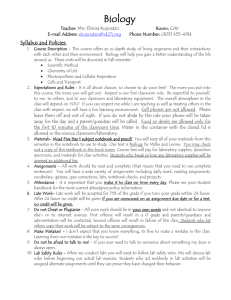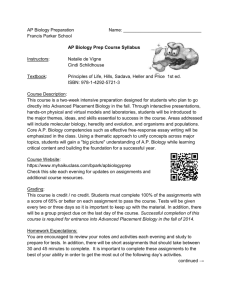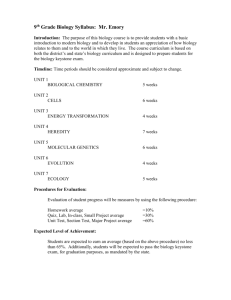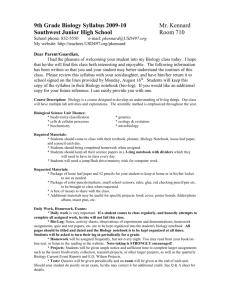Biology AP Summer Assignment
advertisement
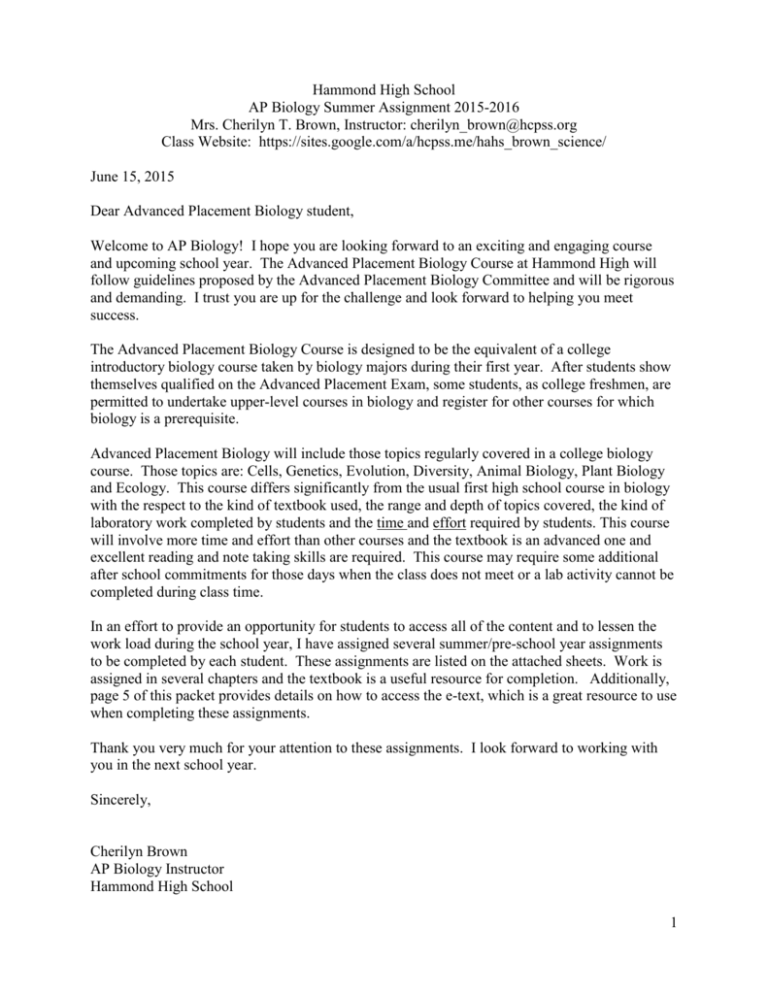
Hammond High School AP Biology Summer Assignment 2015-2016 Mrs. Cherilyn T. Brown, Instructor: cherilyn_brown@hcpss.org Class Website: https://sites.google.com/a/hcpss.me/hahs_brown_science/ June 15, 2015 Dear Advanced Placement Biology student, Welcome to AP Biology! I hope you are looking forward to an exciting and engaging course and upcoming school year. The Advanced Placement Biology Course at Hammond High will follow guidelines proposed by the Advanced Placement Biology Committee and will be rigorous and demanding. I trust you are up for the challenge and look forward to helping you meet success. The Advanced Placement Biology Course is designed to be the equivalent of a college introductory biology course taken by biology majors during their first year. After students show themselves qualified on the Advanced Placement Exam, some students, as college freshmen, are permitted to undertake upper-level courses in biology and register for other courses for which biology is a prerequisite. Advanced Placement Biology will include those topics regularly covered in a college biology course. Those topics are: Cells, Genetics, Evolution, Diversity, Animal Biology, Plant Biology and Ecology. This course differs significantly from the usual first high school course in biology with the respect to the kind of textbook used, the range and depth of topics covered, the kind of laboratory work completed by students and the time and effort required by students. This course will involve more time and effort than other courses and the textbook is an advanced one and excellent reading and note taking skills are required. This course may require some additional after school commitments for those days when the class does not meet or a lab activity cannot be completed during class time. In an effort to provide an opportunity for students to access all of the content and to lessen the work load during the school year, I have assigned several summer/pre-school year assignments to be completed by each student. These assignments are listed on the attached sheets. Work is assigned in several chapters and the textbook is a useful resource for completion. Additionally, page 5 of this packet provides details on how to access the e-text, which is a great resource to use when completing these assignments. Thank you very much for your attention to these assignments. I look forward to working with you in the next school year. Sincerely, Cherilyn Brown AP Biology Instructor Hammond High School 1 Assignment Details 1. All completed assignments will be collected August 28, 2015 with except assignment #1 (which is due August 24, 2015) . I encourage you to divide the assignments over several weeks during the summer. Do not attempt to complete all assignments at once or at the last minute. The reading level may be easy, but the volume is large and you are expected to remember the material from these chapters. 2. Assignments can by typed or neatly handwritten. 3. Repetition is intentional. You may be asked different questions that will require the same answer. You are expected to complete these as if the concept is presented individually. For example, DO NOT write “see number 4 above” or “this answer was given in number 7 of part 1.” 4. There will be a test on these chapters during the second week of class. 5. All assignments will be graded and recorded as a major part of your first quarter grade in AP Biology. Unless previously discussed with the instructor, LATE ASSIGNMENTS ARE ONLY ACCEPTED ONE CLASS PERIOD LATE AND WILL ONLY RECEIVE HALF-CREDIT. 2 Summer Assignments Assignment #1: Letter of Introduction Your first assignment is to successfully send me an email with an attachment. The due date for this assignment is August 24, 2015. Feel free to send this ahead of time. Your email must adhere to the following guidelines: 1. Use clear, full sentences with correct punctuation. Proofread!! Proofread!!!! Proofread!!!! Use spell check before you hit the “send” button. 2. Do not use text language! Do not abbreviate words like you would when texting a friend. Rather, use a formal style of communication in the letter like you would use when writing to your college professor. This will be good practice for communicating with professors in the future. 3. Begin the letter with a formal salutation, like “Mrs. Brown,” or “Dear Mrs. Brown.” 4. Now introduce yourself and tell me a little bit about you. a. What do you like to do (hobbies, sports, music, interests)? b. Tell me a little about your family (Mom/Dad/Guardian, siblings, pets, how long you’ve lived in the area, etc.). c. What do you like most about Biology? d. Why are you taking this class, and what do you hope to learn? e. What are you most anxious about in AP Biology? f. What other AP courses have you taken? What AP courses are you taking next school year? 5. End the email with a formal closing, like “Sincerely.” Then skip four spaces and write your name below the closing like you would if you were writing a letter. 6. Save your letter and sent it to me in an email attachment to cherilyn_brown@hcpss.org by August 24, 2015. 7. Make the subject heading: AP Biology Letter of Introduction: (Your first and last name). Do not include the parentheses; just add your first and last name. 3 Assignment #2: Learning Style Assessment Knowing your learning style can be beneficial to your success in class. Use http://www.edutopia.org/multiple-intelligences-learning-styles-quiz to find what your learning style is. Once you complete the assessment, print your results and write a brief reflection using the guidelines below. Include a proper heading with your name, date, and a title on the reflection and attach your learning style assessment results. Submit this assignment by Friday, August 28, 2015. a. Introduction i. Why is it important for you to know your own learning style? ii. What can you do with the results of the learning style inventory? b. Body Paragraph i. What type of learner are you? ii. How do you learn best? iii. What are some suggestions to make you a successful student? iv. What did you learn about how you learn? v. What did you learn about how you work in a group? vi. What are some suggestions to make your more successful when working in a group or alone? c. Conclusion paragraph i. What did you learn about yourself through taking this inventory? ii. Set some goals for yourself regarding this course and the exam. 4 Assignment #3: AP Biology Reading Guide for Unit 1 - Chapters 1-5 Complete the reading guides for unit 1 - chapters 1 through 5. You can download the Reading Guides from the class website: https://sites.google.com/a/hcpss.me/hahs_brown_science/ In the left column under “AP Biology” click the “Study Guide” tab. Download and print the reading guides and complete using the e-text. You may write the answers on the handout or you may use a separate sheet of paper. Please use complete sentences for all responses. These Reading Guides are helpful learning tools. The goal of the guides is not simply completion but to help you learn and review areas of the text that are commonly addressed on the AP Biology exam. The amount of effort you put into each Guide will be reflected in what you learn, so work hard! The information needed to complete these Reading Guides is found in Campbell, Reece, 9th Edition AP Biology. Chapter 1: Introduction: Themes in the Study of Life Chapter 2: The Chemical Context of Life Chapter 3: Water and Life Chapter 4: Carbon and the Molecular Diversity of Life Chapter 5: The Structure and Function of Large Biological Molecules You will have a test on these 5 chapters during the second week of the new school year. The test will consist of multiple choice and free response questions. ACCESS TO CAMPBELL’S eText/COURSE PAGE 1. Use this access number STUDENT ACCESS NUMBER: SSNAST-SUNUP-SKELF-TURVY-AFOOT-JOKES 2. Please visit http://phschool.com/access to register. 3. Enter the first six letters of the student access number above. 4. On the next screen, click the “Covered Title” link, select Science, select: Campbell, Biology 9e AP® Edition MasteringBiology. 5. Then click on Student Registration and a new window will open where you can enter the access code above and register for a Pearson account if you don’t already have one. 6. When asked if your instructor has provided you with a course code, click “yes” and enter the following code: MBBROWN10387 7. Enter your HCPSS issued Student ID. 8. The e-text link (blue) is located near the top left of the main MasteringBiology page. 5


